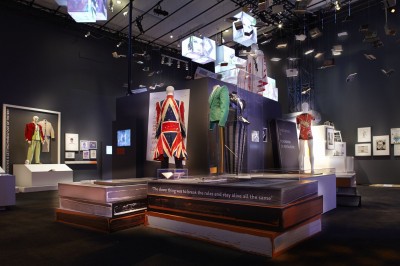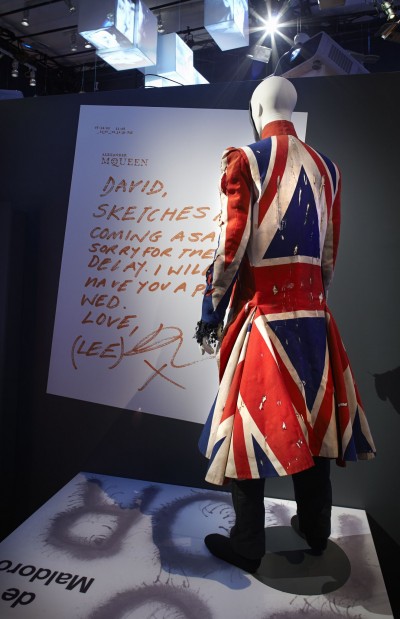By Peter Saunders
Last fall, the Art Gallery of Ontario (AGO) hosted the North American debut of ‘David Bowie is,’ a new hit exhibition organized by the Victoria and Albert (V&A) Museum in London, England. From September 25 to November 29, 2013, the Toronto venue hosted more than 300 objects from the famous, groundbreaking British pop musician’s personal archive, including iconic stage costumes, audio recordings, notes, sketches, photos, lithographs, posters, set designs, album artwork, interviews and video footage, spanning the five decades since Bowie was a teenager.
As the first stop on the exhibition’s world tour, the AGO was something of a testing ground for adapting the V&A’s multimedia experience—which the New York Times described as “unified in sound and vision in a way rarely seen in a museum”—so it can be hosted in other facilities.
“We are thrilled to work with the V&A in bringing the provocative vision of David Bowie to Toronto,” said Matthew Teitelbaum, director and CEO of the AGO. “This is a once-in-a-lifetime opportunity to celebrate a living artist who has had an enormous influence on design and contemporary culture. His willingness to defy genres has made his career a barometer for cutting-edge performance art.”

Based on designs sent from England, Toronto-based Holman Exhibits printed vinyl graphics and wrapped them on oversized ‘books’ for the AGO exhibition.
With the opportunity came a significant challenge, however, as 14 exhibit areas on the fourth and fifth floors of the AGO’s contemporary tower needed to be built out with extensive display walls, cases and other structures. Toronto-based Holman Exhibits, already a trusted partner to the AGO, was called upon to manage this fabrication and installation work under tight timelines. A dedicated 45-member team assigned to the project kept it on track over an eight-week period.
“The whole schedule was driven by the opening day,” says Chris Marshall, senior manager for Holman.
Unlike any other
The exhibition’s run at the V&A marked the first time any museum has been allowed to display items from Bowie’s archive. Victoria Broackes and Geoffrey Marsh, the V&A’s theatre and performance curators, worked with Sandy Hirshkowitz, the archivist for Bowie’s collection, to carefully select costumes, objects and footage for the exhibition. The curators never met Bowie himself.
“He doesn’t throw things away,” says Broackes. “Ever since David Robert Jones started to construct the identity of David Bowie in 1967, he’s been curating himself, celebrating many different personalities. We wanted that creative spirit in our exhibition’s design—it shouldn’t be like any other museum exhibit.”
‘David Bowie is’ sold more than 67,000 advance tickets and attracted more than 300,000 visitors during its five-month run at the V&A, breaking all previous records. Broackes and Marsh also co-edited and contributed to a book associated with the exhibition, which in turn is the first permanent volume authorized by and permitted full access to Bowie’s archive.

The exhibition placed a strong emphasis on David Bowie’s many stage costumes. Custom mannequins had to be manufactured with Bowie’s 26-inch waist.
Adapting designs
When the time came to bring the exhibition to Toronto, much of the V&A experience had to be recreated, since only the artifacts themselves were being sent over, not the various temporary structures that displayed them.
“Each room in the exhibition was like a box,” says Edgars Apse, Holman’s marketing manager. “Our structures added depth, projection surfaces and paths to all of the artifacts. We fabricated and installed all of the cabinetry, display surfaces and temporary walls. Several pieces involved printing and applying vinyl graphics.”
These included oversized ‘books’ that were wrapped with full-colour graphics produced with Holman’s new flatbed printer. All of these were based on designs sent over from England.
“The exhibition was redesigned for the AGO and we received three-dimensional (3-D) modelling files,” explains Holman’s Marshall. “It was a bit of a challenge, because the company that designed it in England didn’t build it. We got the new design drawings, then the V&A’s fabrication drawings, and had to figure out which would work best.”
The AGO also produced some signage itself, printing text onto graphic panels, which allowed its curators to control all of the messaging.
“These were small enough pieces that they could create them at their internal workshop,” Marshall explains.
With a compressed schedule, the fabrication and installation process had to be streamlined, so communications channels were opened with the AGO to expedite approvals. The various pieces were built at Holman’s facility, then assembled on-site at the AGO, where adjustments could be made as required.






